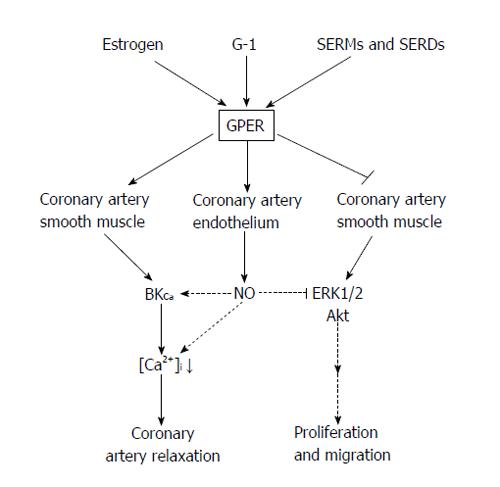Copyright
©2014 Baishideng Publishing Group Inc.
World J Cardiol. Jun 26, 2014; 6(6): 367-375
Published online Jun 26, 2014. doi: 10.4330/wjc.v6.i6.367
Published online Jun 26, 2014. doi: 10.4330/wjc.v6.i6.367
Figure 1 Summary of proposed mechanisms mediating the effects of G-protein-coupled estrogen receptor activation in coronary arteries.
GPER is activated by 17β-estradiol and the selective agonist, G-1. In addition, selective estrogen receptor modulators (e.g., raloxifene, tamoxifen) and selective estrogen receptor down regulators (e.g., ICI182,780) also appear to be agonists for GPER. GPER activation induces an endothelium-independent relaxation of coronary artery smooth muscle mediated by the large-conductance, calcium-activated potassium channel. In addition, GPER activation can stimulated release of NO from coronary endothelial cells to relax these arteries. Besides this vasodilatory effect, GPER activation can attenuate proliferation and migration of coronary artery smooth muscle cells by inhibiting signaling via the ERK1/2 and Akt pathways. GPER: G-protein-coupled estrogen receptor; SERMs: Selective estrogen receptors modulators; SERD: Estrogen receptor down regulator; ERK: Extracellular signal-regulated protein kinase.
- Citation: Han G, White RE. G-protein-coupled estrogen receptor as a new therapeutic target for treating coronary artery disease. World J Cardiol 2014; 6(6): 367-375
- URL: https://www.wjgnet.com/1949-8462/full/v6/i6/367.htm
- DOI: https://dx.doi.org/10.4330/wjc.v6.i6.367









